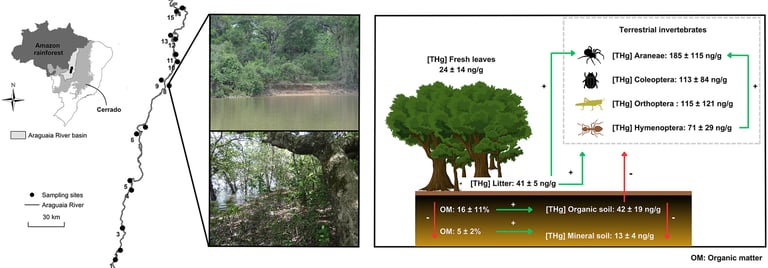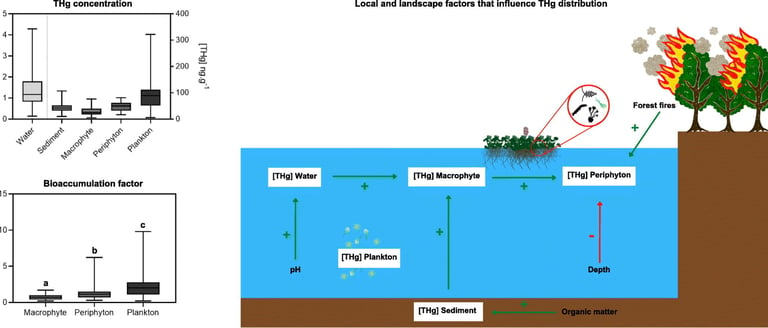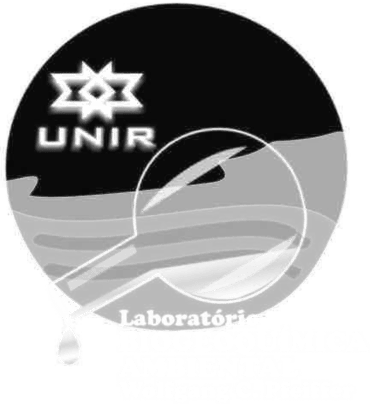Publicações 2024
Amazon, Honey, Bee, Fish, Mercury hair, Riverside Community, Bioaccumulation, Biomagnification, Riparian ecosystems, Neotropical, Savanna, Floodplain, Araguaia River, Central Brazil, Uptake, Biomonitoring, Indicator kriging, Spatial dependence, Paspalum repens, Cerrado, hypertensive disorders, pregnancy, saúde infanto-juvenil, methylmercury, heart mitochondria, electrocardiography, echocardiography, ergospirometry, oxidative phosphorylation system,contamination, fishing, Hg, human exposure, MeHg, rays, sharks, stable isotopes, viveiro, sal de tetrazólio, germinação, índice de velocidade de emergência.
ARTIGOS & PERIÓDICOS
Assessment of mercury bioaccumulation in a tropical elasmobranch assemblage
Andréia S. Campos, Moisés F. Bezerra, Victor L. Moura, Vicente V. Faria, Carlos E. Rezende, Wanderley R. Bastos, Iuri Aparecida S. Oliveira and Luiz D. Lacerda
DOI: https://doi.org/10.36229/978-65-5866-431-4.CAP.11
Abstract:
Environmental context
Mercury (Hg) is a non-essential metal that can accumulate in aquatic biota, including top predators such as elasmobranchs (sharks and rays) and biomagnifying along the trophic web. This study provides data on Hg total, methylmercury (MeHg) and stable isotopes (δ13C and δ15N) for 13 elasmobranch taxa in the Equatorial Western Atlantic Ocean, relating biological and ecological properties with Hg concentrations and the estimated human consumption risk.
Rationale
Elasmobranchs widely consume fish, making understanding Hg bioaccumulation crucial. Little is known about Hg distribution in their bodies beyond muscle tissue and the associated health risks for both animals and humans who consume them.
Methodology
This study evaluated Hg, methyl-Hg (MeHg) and stable isotopes (δ13C and δ15N) in the muscle, liver and brain of 13 elasmobranch taxa landed by artisanal fisheries on the Western Equatorial Atlantic Ocean.
Results
The study revealed that Hg concentrations were highest in muscle tissue, whereas the brain exhibited the greatest percentage of MeHg. Significant correlations between Hg levels and body size, as well as between muscle and brain Hg concentrations, were observed in sharks. Stable isotope values indicated dietary and habitat diversity, and a significant correlation between Hg (log10) and δ15N was found. Mercury concentrations exceeded thresholds for harmful effects in ~76% of the analysed taxa and were also detected in embryos. These taxa also surpassed the local consumption limits, highlighting a potential risk.
Discussion
The results demonstrated bioaccumulation and biomagnification of Hg in the studied taxa. Muscle Hg was a good predictor of brain Hg levels as a result of the significant correlation between these variables. The high proportion of MeHg in the brain indicates rapid transport of Hg to this organ. Observed Hg concentrations in juveniles and adults may affect their health, whereas concentrations in embryos indicate possible transfer of Hg from the mother to the embryos. This study advises caution when consuming various elasmobranchs, depending on the consumer’s weight and meal frequency.
Mitochondrial Dysfunction Plays a Relevant Role in Heart Toxicity Caused by MeHg
Marcia Gracindo Silva, Camila Guerra Martinez, Joao Paulo Cavalcanti de Albuquerque, André Luiz Gouvêa, Monica Maria Freire, Leidiane Caroline Lauthartte, Julio Mignaco, Wanderley Rodrigues Bastos, Elisabete Cesar de Mattos, Antonio Galina and Eleonora Kurtenbach
Abstract: Background: The effects of methylmercury (MeHg) on exposed populations are a public health problem. In contrast to widely studied neurological damage, few cardiovascular changes have been described. Our group evaluated the cardiotoxicity of a cumulative dose of 70 mg.kg⁻¹ fractioned over a 14-day exposure period in mice (MeHg70 group). The effects of MeHg on proteins relevant to cardiac mitochondrial function were also investigated. The results obtained showed a reduction in oxygen consumption in the two settings. In cardiac tissue samples in oxygraphy studies, this reduction was related to a lower efficiency of complexes II and V, which belong to the oxidative phosphorylation system. In vivo, mice in the MeHg70 group presented lower oxygen consumption and running tolerance, as shown by ergometric analyses. Cardiac stress was evident in the MeHg70 group, as indicated by a marked increase in the level of the mRNA encoding atrial natriuretic peptide. Electrocardiogram studies revealed a lower heart rate at rest in the animals from the MeHg70 group, as well as prolonged left ventricular depolarisation and repolarisation. Through echocardiographic analysis, reductions in the left ventricular ejection fraction and left ventricular wall thickness of approximately 10% and 20%, respectively, were detected. These results indicate that the oral intake of MeHg can decrease cardiac function and oxidative metabolism. This finding highlights the importance of monitoring MeHg levels in humans and animals in contaminated areas, as well as periodically carrying out cardiac function tests.
Condição de saúde infanto-juvenil em comunidades ribeirinhas na Amazônia brasileira: estudo transversal
Vanessa Alves Mendes, Laís Xavier Araújo, Priscilla Perez da Silva Pereira, Jeanne Lúcia Gadelha de Freitas, Dario Pires de Carvalho, Wanderley Rodrigues Bastos
Abstract: Background: Social determinants interfere in the health-disease process of the riverside population, associated with territorial isolation and restricted access to health goods and services. Objective: The objective of this study was to identify factors associated with the health conditions of children and adolescents and their mothers, from two riverside communities on the Madeira River, Amazonas, Brazil. Method: A cross-sectional study was carried out in April and August 2017 in two riverside communities in the Amazon, with mothers, children, and adolescents up to 19 years old. Sociodemographic conditions and maternal and health characteristics of children and adolescents were evaluated. Poisson regression analysis was performed using Stata 13. Results: Of the 94 participating mothers, 56.4% declared their children’s health conditions as fair to bad. The regular and poor health condition of children and adolescents was associated with the place of residence, number of appliances, daily consumption of snacks, sweets, and artificial juice, having a chronic disease, and having a history of hospitalization once in a lifetime (p<0.05). In the adjusted model, only hospitalization had a statistically significant association (PR=1.60; 1.13–2.26) with regular and poor health. Conclusion: Children and adolescents in the evaluated communities are vulnerable to illness due to precarious socioeconomic factors, sanitary conditions, and low access to health services.
Environmental exposure to metal(loid)s and hypertensive disorders of pregnancy: A systematic review
Nayra Carla de Melo, Priscilla Cristovam Sampaio e Souza, Rejane Correa Marques, Jose Vicente Elias Bernardi, Wanderley Rodrigues Bastos, Mônica Pereira Lima Cunha
Abstract: Background Environmental exposure to metal(loid)s has been associated with adverse effects on human health, but the systemic repercussion of these elements on the development of hypertensive disorders of pregnancy (HDP) is still poorly understood. Objective To summarize evidence published about the influence of environmental exposure to aluminum, arsenic, barium, cadmium, lead, strontium and mercury on the development of HDP. Methods We conducted a systematic literature review according to the guidelines of the Preferred Reporting Items for Systematic Reviews and Meta-Analyses. The search strategy was validated by the Peer Review of Electronic Search Strategies. We searched for articles published up to February 2023 in seven databases without language restriction. Two researchers conducted the steps for selection, data extraction and evaluation of the methodological quality of the instruments for epidemiological studies of the Joanna Briggs Institute. Any disagreements were resolved by a third researcher. Results We obtained 5076 records, of which 37 articles met the inclusion criteria moderate to high methodological quality. Single exposure to metal(loid)s was predominant, and the leading biological matrix analyzed to detect the concentrations from exposure was maternal blood. Lead was the metal investigated the most, and had the largest number of studies showing positive association with HDP. In relation to the other metal(loid)s, higher levels were found in women with HDP in comparison with healthy women, but the finding of a cause-effect relationship was inconsistent. Conclusions Although we found evidence of harmful effects of the metal(loid)s studied on human health, the results were inconclusive with regard to HDP. Longitudinal studies that consider prospective investigation, adjustment of confounding factors and the interference of other contaminants in the exacerbation of oxidative stress in women from the preconception phase to the puerperal period should be encouraged.
Mercury Bioconcentration and Translocation in Rooted Macrophytes (Paspalum repens Berg.) from Floodplain Lakes in the Araguaia River Watershed, Brazilian Savanna
Lucas Cabrera Monteiro, Ludgero Cardoso Galli Vieira, José Vicente Elias Bernardi, Ygor Oliveira Sarmento Rodrigues, Lígia Pereira Borges de Mesquita, João Pedro Rudrigues de Souza, Guilherme Sena, Iuri Aparecida da Silva Oliveira, Cássio da Silva Cabral, José Francisco Gonçalves Júnior, Jurandir Rodrigues de Souza and Wanderley Rodrigues Bastos
Abstract: Macrophytes are fundamental photosynthetic organisms for functioning freshwater ecosystems, identified as potential bioindicators of mercury (Hg) in the environment. We quantified the concentrations of total Hg (THg) in water and macrophytes (Paspalum repens Berg.) from 17 lakes on the Araguaia River floodplain, aiming to compare the bioconcentration factor (BCF) in the aerial tissues and roots; evaluate the translocation factor (TF) between plant tissues; and assess the influence of environmental factors and land use on THg concentrations in water and macrophytes. The BCF was significantly higher in roots (1.29 ± 0.32) than in aerial tissues (0.41 ± 0.34), with low TF between plant tissues (0.14 ± 0.06). The highest concentrations of THg in water were determined in lakes with higher land use intensity and a pH close to neutral, indicating the transport of particulate-bound Hg and the immobilization in the water column. In contrast, wetlands were priority areas for the bioconcentration of THg in macrophytes, associated with sulfate, dissolved oxygen, and oxidation–reduction potential in the water. Thus, although P. repens is not a suitable bioindicator of Hg mobilization by anthropogenic land use in our study area, our results suggest the potential of macrophytes as bioindicators of sites that are favorable to Hg methylation.
Mercury distribution, bioaccumulation, and biomagnification in riparian ecosystems from a Neotropical savanna floodplain, Araguaia River, Central Brazil
Lucas Cabrera Monteiro, Ludgero Cardoso Galli Vieira, José Vicente Elias Bernardi, Maria Cristina Nery do Nascimento Recktenvald, Adriely Ferreira da Costa Nery, Iara Oliveira Fernandes, Vinicius Lima de Miranda, Dulce Maria Sucena da Rocha, Ronaldo de Almeida e Wanderley Rodrigues Bastos


Graphical Abstract
Abstract: Litterfall is the main source of dry deposition of mercury (Hg) into the soil in forest ecosystems. The accumulation of Hg in soil and litter suggests the possibility of transfer to terrestrial vertebrates through environmental exposure or ingestion of plant tissues. We quantified total mercury (THg) concentrations in two soil layers (organic: 0 - 0.2 m; mineral: 0.8 - 1 m), litter, fresh leaves, and terrestrial invertebrates of the Araguaia River floodplain, aiming to evaluate the THg distribution among terrestrial compartments, bioaccumulation in invertebrates, and the factors influencing THg concentrations in soil and invertebrates. The mean THg concentrations were significantly different between the compartments evaluated, being higher in organic soil compared to mineral soil, and higher in litter compared to mineral soil and fresh leaves. Soil organic matter content was positively related to THg concentration in this compartment. The order Araneae showed significantly higher Hg concentrations among the most abundant invertebrate taxa. The higher Hg concentrations in Araneae were positively influenced by the concentrations determined in litter and individuals of the order Hymenoptera, confirming the process of biomagnification in the terrestrial trophic chain. In contrast, the THg concentrations in Coleoptera, Orthoptera and Hymenoptera were not significantly related to the concentrations determined in the soil, litter and fresh leaves. Our results showed the importance of organic matter for the immobilization of THg in the soil and indicated the process of biomagnification in the terrestrial food web, providing insights for future studies on the environmental distribution of Hg in floodplains.
Local and landscape factors influencing mercury distribution in water, bottom sediment, and biota from lakes of the Araguaia River floodplain, Central Brazil
Lucas Cabrera Monteiro, Ludgero Cardoso Galli Vieira, José Vicente Elias Bernardi, Wanderley Rodrigues Bastos, João Pedro Rudrigues de Souza, Maria Cristina Nery do Nascimento Recktenvald, Adriely Ferreira da Costa Nery, Iuri Aparecida da Silva Oliveira, Cássio da Silva Cabral d, Lilian de Castro Moraes, Cleber Lopes Filomeno, Jurandir Rodrigues de Souza
Graphical Abstract


Abstract: Mercury (Hg) is a chemical element widely present in the Earth’s crust. However, its high toxicity and ability to accumulate in organisms and biomagnify through food chains characterize it as a global pollutant of primary control. We assessed total mercury concentrations ([THg]) in abiotic and biotic compartments from 98 floodplain lakes associated with the Araguaia River and six tributaries (Midwest Brazil). [THg] quantification in water was performed by cold vapor atomic fluorescence spectroscopy. [THg] in bottom sediment was assessed using cold vapor generation atomic absorption spectrophotometry, while [THg] in macrophyte, periphyton, and plankton were quantified by thermal decomposition atomic absorption spectrometry. Hotspots of [THg] in water, bottom sediment, and macrophytes were determined in areas impacted by pasture and urban areas. In contrast, hotspots of [THg] in periphyton and forest fires were determined in preserved areas downstream. [THg] in plankton did not show a clear spatial distribution pattern. The mean bioaccumulation factor order was plankton (2.3 ± 1.8) > periphyton (1.3 ± 0.9) > macrophytes (0.7 ± 0.4) (KW = 55.09, p < 0.0001). Higher [THg] in water and bottom sediment were associated with high pH (R²adj = 0.118, p = 0.004) and organic matter (R²adj = 0.244, p < 0.0001). [THg] in macrophytes were positively influenced by [THg] in water (R²adj = 0.063, p = 0.024) and sediment (R²adj = 0.105, p = 0.007). [THg] in periphyton are positively related to forest fires (R²adj = 0.156, p = 0.009) and [THg] in macrophytes (R²adj = 0.061, p = 0.03) and negatively related to lake depth (R2adj = 0.045, p = 0.02). The transfer of Hg from water and sediment to the biota is limited. However, the progressive increase of the bio accumulation factor between macrophyte, periphyton, and plankton may indicate Hg biomagnification along the food chain of the Araguaia River floodplain.
Mercury in honey of stingless bee species from Brazil’s south, southeast and north (Amazon) regions
Natália A. Campos, Gabriel H.A. Holanda, Maria C.N.N. Recktenvald, Walkimar A. Costa-Júnior, Ludimilla Ronqui, Rejane S. Parpinelli, Josiel D. Froelich, Wanderley R. Bastos and Débora F. Oliveira


Graphical Abstract
Abstract: Food produced in regions with intense industrial or mining activity can be contaminated with heavy metals, including mercury (Hg). Human exposure to this metal can cause serious health problems. The aim of this study was to quantify and compare the levels of total Hg (THg) in samples of honey (n=44) produced by five species of stingless bees, as well as to compare the THg values among the collection regions. Samples were obtained from three Brazilian states, one each in the South, Southeast and North regions (respectively Paraná, São Paulo and Rondônia, the last in the Amazon rainforest). The average THg level in the honey samples was 0.00060 mg.kg⁻¹. The results also indicated a significant difference among the collection places. The high variability of the THg values in the honey samples might have been related to the territory foraged by the bees and the types of plants visited, but not the species or their behavior. The divergence among the average levels found for the different collection areas could have been a reflection of the types of predominant industrial activities in the analyzed regions.
A 35-Year Record (1987–2022) of Hg Concentrations in Two of the Fish Species Most Consumed by People Living in the Upper Madeira River Basin, Brazilian Amazon Region
Luiz Drude de Lacerda, Ronaldo de Almeida and Wanderley Rodrigues Bastos
Abstract: This study presents a 35-year record of total mercury (Hg) concentrations in the detritivore fish Prochilodus nigricans (Curimatã) and the carnivore Cichla pleiozona (Tucunaré), two of the most widely distributed, ecologically important and consumed fish species in the upper Madeira River Basin in the Western Brazilian Amazon. Fish samples from the major Madeira River and marginal lakes and tributaries were compared. Irrespective of site, Hg concentrations were higher in the carnivore fish compared to the detritivore. Hg concentrations increased 5-fold in C. pleiozona in the past three decades, whereas they remained relatively constant in P. nigricans when analyzing the entire 35-year period. When analyzed separately, fish in the main river and marginal lake and tributaries presented the same pattern of Hg variation, with a significant increase in Hg concentrations in the carnivore and in the detritivore in marginal lakes and tributaries but not in the main river. This was in line with the increase in methyl-Hg production in tributaries, mostly associated with deforestation in the past decade in the basin. Although an increase in direct emissions from artisanal gold mining also occurred in the past decade, this caused virtually no impact on fish Hg concentrations, suggesting atmospheric emission and deposition in forests and further export to water systems as an intermediate link with fish Hg concentrations.
Mercury in Fish and Human Hair and Estimated Dietary Intake in a Riverside Community of the Madeira River Basin in the Brazilian Amazon
Thayson Araujo Canela, Lucas Cabrera Monteiro, Cássio da Silva Cabral, Fábio da Silva Ximenes, Iuri Aparecida da Silva Oliveira, José Vicente Elias Bernardi, Ronaldo de Almeida and Wanderley Rodrigues Bastos
Abstract: Mercury (Hg) is a chemical element that poses risks to human health due to its high toxicity and environmental persistence. We determined the total Hg (THg) and methyl Hg (MeHg) concentrations in hair samples from residents of the Demarcação District (Porto Velho, Rondônia) in the Brazilian Amazon, as well as in water and fish samples, to evaluate factors influencing human exposure. The average THg concentration in human hair was 7.86 ± 6.78 mg kg⁻¹ and it was significantly higher in men, with an increasing trend related to age. There was no significant difference between female age groups. Human exposure to Hg through water was negligible compared to fish consumption. The average weekly intake estimates in the community varied between 1.54 and 4.62 µ kg⁻¹, substantially higher than the recommended limit. The fish species with the highest amounts safe for daily consumption were herbivores and detritivores. Our results contribute to an understanding of how exposure to Hg affects the health of riverside populations and provide insights for new research to develop methods to mitigate such exposure and thus improve the quality of life of Amazonian people.
First record of mercury concentrations and stable isotopes (¹³C & ¹⁵N) in albacore (Thunnus alalunga) from the Western Equatorial Atlantic Ocean
Luiz Drude de Lacerda, Felipe A. de Alencar Goyanna, Guelson Batista da Silva, Carlos Eduardo de Rezende, Wanderley Rodrigues Bastos, Moisés Fernandes Bezerra
Abstract: This paper reports the first record of total mercury (THg) concentrations in albacore (Thunnus alalunga), one of the main tuna species caught from the Western Equatorial Atlantic Ocean and presents a preliminary comparison with other regions and tuna species. Mean, standard deviation and range of concentrations in T. alalunga (515 ± 145 ng g⁻¹ ww; 294–930 ng g⁻¹ ww) with 92 % being of methyl-Hg, are higher than in albacore from other Atlantic Ocean subregions despite their smaller body size. These concentrations are similar to those from the Pacific and Indian oceans, but lower than in the Mediterranean. Compared to other sympatric tuna species, concentrations are higher than those in T. albacares and similar to T. obesus. These results are discussed considering the potential differences in stable isotope values (¹³C and ¹⁵N) of T. alalunga populations from multiple oceanic areas and compared to other tuna species worldwide.
Capítulo 11 - Qualidade das sementes de Ochroma pyramidale (Cav. ex Lam.) Urb. após acondicionamento em sacos de polietileno e sacos kraft em condições ambientais de laboratório. In Sustentabilidade, Meio Ambiente e Responsabilidade Social: Artigos Selecionados - Volume 4, J. H. P. Silveira (Ed.)
Caproni, A. L., Almeida, R. de, Bastos, W. R., Vargas, T. F., Pereira, M. R. S., Junior, D. G. da S., Granha, J. R. D. de O.
Abstract: Este estudo teve como objetivo avaliar a viabilidade e a germinação de sementes de O. pyramidale após tratamentos de quebra de dormência e diferentes condições de armazenamento. As sementes foram extraídas de frutos coletados e secados ao ar livre, acondicionadas em sacos de papel kraft e de polietileno, e armazenadas por 4 e 6 meses em condições de laboratório. Foram aplicados tratamentos com água a 80°C por 8 e 15 minutos, seguidos de choque térmico com água à temperatura ambiente, e as sementes foram pré-condicionadas em água por 24 horas antes da avaliação de viabilidade com sal de tetrazólio. O experimento incluiu três repetições de 50 sementes em substrato de areia e de terra orgânica, em um delineamento inteiramente casualizado (DIC). Os resultados indicaram maior viabilidade das sementes armazenadas em sacos kraft após o tratamento térmico em comparação com aquelas em sacos de polietileno. O tratamento de quebra de dormência foi eficaz em aumentar a velocidade de emergência das plântulas.





